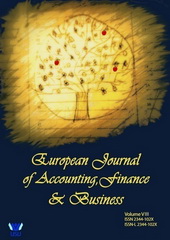| |
Article from Volume 7, Number 3, Year 2019| ACCOUNTING INSTRUMENTS USED IN DECISION ANALYSIS | 
Download | | Author(s): Florin Boghean | | DOI: 10.4316/EJAFB.2019.738 | | Abstract: The research carried out in this article is a Behavioral Accounting Research, based on the following approach: How do individuals react to various issues in the field of accounting? The main purpose of this type of research is to describe the current decision-making behavior, to evaluate the quality of this process, as well as to develop and test theories in the sphere of psychological processes, which determine the behavior. Therefore, the content of this article will be based on the deductive approach, starting from theory to practice, with some research trends designed to verify the extent to which certain theoretical aspects mentioned above are confirmed by the practice in the field. | | Keywords: Accounting, Decisional Process, Risk Management. | References:
1. Andrews, K. (1971). The Concept Of Corporate Strategy, Irwin, Homewood.
2. Azuma, R., Daily, M., Furmanski, C. (2006). A Review Of Time Critical Decision Making Models And Human Cognitive Processes. In Aerospace Conference.
3. Behnam, M. (2012). Decision Making Process: Typology, Intelligence, And Optimization, J IntellManuf, 23,Springer, 733–746.
4. Burciu, A. (2008). Management Comparat, Economica, Bucharest.
5. Chartered Global Management Accountant. (2016). Joining The Dots: Decision Making For A New Era, Https://www.cgma.org/content/dam/cgma/resources/downloadabledocuments/joining-the-dots-report.pdf, Retrieved October 15, 2019.
6. Cordell, D.M. (2002). Risk Tolerance In Two Dimensions, Journal Of Financial Planning, 15(5),30-36.
7. Dessler, G., (2004). Management, Pearson Education Inc., New Jersey, SUA.
8. Filip, R. (2012). Management Interna?ional, ASE, Bucharest, Romania.
9. Grable, J., Roszkowski, M., Joo, S., O'Neill, B., Lytton, R. (2009). A Test Of The Relationship Between Self Classified Financial Risk-tolerance And Investment Risk-taking Behaviour, International Journal Of Risk Assessment And Management, 12(2-4), 396 – 419.
10. Grable, J.E. (2008). Risk Tolerance, In Xiao, J. J., (ed.), Handbook Of Consumer Finance Research, Springer, New York, USA.
11. Lawrence, J., Pasternak, B. (1998). Applied Management Sciences. A Computer-Integrated Approach For Decision Making, John Wiley &Sons, Inc.
12. Mai, M., Tchemeni, E. (1996). Publication De Previsions Par Le Dirigeants, Economies Et Societes, Serie Sciences De Gestion.
13. Endsley, M.R., Hoffman, R., Kaber, D. (2007). Cognitive Engineering And Decision Making: An Overview And Future Course, Journal Of Cognitive Engineering And Decision Making (JCEDM), 1(1), 1-21.
14. Poeter, M. E.(1990). Moix Stratégiques Et Concurrence, Economico, Paris, France.
15. Sankaranarayanan, V., Chandrasekaran, M., Upadhyaya, S. (2007). Towards Modeling Trust Based Decisions: A Game Theoretic Approach, Computer Security–ESORICS Springer, Heidelberg, Berlin.
16. Watts, R., Zimmerman, J. (2000). Positive Accounting Theory: A Ten Year Perspective, The Accounting Review, 65(1), 95-112.
|
| | Back to journal ... |
|
|

